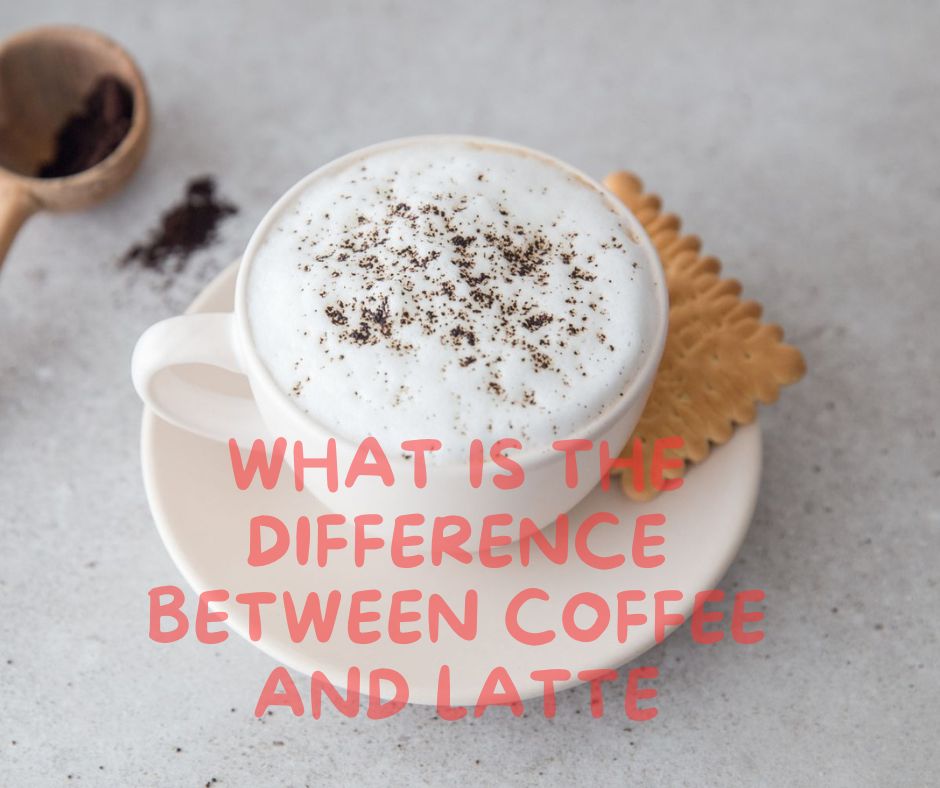Coffee and latte are two widely consumed drinks across the world. While they both include coffee, their processing, and ingredients differ significantly, giving them unique tastes and textures. A latte is a more sophisticated drink prepared with espresso and steamed milk, whereas coffee is a basic drink produced by boiling coffee beans with hot water. In this blog article, we’ll go through the distinctions between coffee and latte in depth to help you decide which one is best for you.
What Is The Difference Between Coffee And Latte

Brief Introduction About Coffee
Coffee is a popular beverage that is created by steeping roasted coffee beans in hot water. It is thought to have originated in Ethiopia and became popular as a beverage in the 15th century. Coffee is now appreciated worldwide and is the second most traded commodity after oil. Caffeine, a natural stimulant, can assist boost attention and alertness. Coffee is available in several varieties, including black coffee, which is served without any additions, and coffee with milk, such as a latte or cappuccino. Coffee is a cherished beverage million of people enjoy daily due to its rich scent and robust flavor.
What is Latte?
A latte, often known as a cafe latte, is an espresso-based drink popular in Italy. A shot of espresso is mixed with heated milk and topped with a thin coating of froth. Lattes are traditionally served in tall glasses and can be sweetened with syrups such as vanilla or caramel. The heated milk in a latte gives it a creamy texture and a mild, somewhat sweet flavor that complements the powerful flavor of the espresso. Lattes are a popular choice for individuals who desire the rich flavor of coffee with the comfort of a warm, frothy drink.
4 Key Differences Between Latte vs Coffee / What Is The Difference Between Coffee And Latte
- Taste
- Caffeine Content
- cost
- preparation
Latte and coffee are two widely consumed drinks across the world. While both include coffee, they differ significantly in taste, caffeine amount, cost, and preparation. Here are the four main distinctions between latte and coffee:
- Taste is one of the key distinctions between latte and coffee. A latte has a creamy, smooth taste with a moderate coffee flavor, whereas coffee has a strong, robust flavor with a somewhat bitter taste.
- Caffeine Content: The caffeine content is another distinction. A cup of coffee has more caffeine in it than a latte. The quantity of caffeine in coffee varies based on the kind of coffee bean and the manner of brewing, but an 8-ounce cup of coffee has around 95 mg of caffeine on average. An 8-ounce latte, on the other hand, has just approximately 63 milligrams of caffeine.
- Latte drinks are often more pricey than standard coffee drinks. This is due to the inclusion of components such as steamed milk and froth, which raises the price of the drink. A latte may cost between $3 and $5 on average, whereas a normal coffee can cost as low as $1.
- Preparation: The preparation of coffee and latte differs as well. A latte is created using espresso, steamed milk, and froth, whereas coffee is produced by boiling coffee beans in hot water. Making a latte necessitates the use of specialist equipment, such as an espresso machine, which may be costly.
How to make a tasty latte a complete process?
Here is a step-by-step process for making a tasty latte:
- Grind fresh coffee beans: To produce a shot of espresso, grind fresh coffee beans. For the greatest results, use a fine grind.
- Make an espresso shot: Using an espresso machine, make a shot of espresso.
- Steam the milk as follows: Fill a pitcher halfway with cold milk and steam it with a steam wand until it acquires a creamy, velvety texture. This should just take 20-30 seconds.
- Pour the espresso: Pour the espresso shot into a cup.
- Steamed milk: Holding the pitcher at an angle, pour the steamed milk into the cup, filling it about two-thirds full.
- Scoop off the froth on top of the milk with a spoon and add it to the latte.
- Swirl and serve: Gently swirl the latte to combine the espresso, milk, and froth. Serve immediately and enjoy!
Here is a step-by-step process for making a tasty coffee:
- Fresh coffee beans should be ground to a medium-coarse consistency. For the greatest results, use a burr grinder.
- Bring fresh water to a boil at 200-205°F.
- Fill the filter with coffee grounds: Fill a filter in a pour-over or drip coffee maker with coffee grounds.
- Pour a tiny quantity of hot water over the coffee grinds to evenly soak them.
- Brew the coffee by slowly pouring hot water in a circular motion over the coffee grounds. Use 1-2 teaspoons of coffee for every 6 ounces of water.
- Allow it to steep: Allow the coffee to steep for 3-4 minutes, or until it reaches the desired strength.
- Serve and have fun: Fill a cup halfway with coffee and serve. To taste, add milk, cream, sugar, or other flavorings.
Is A latte stronger than coffee?
No, a latte is not usually stronger than coffee. While a latte contains coffee, it also contains steamed milk and froth, which dilutes the coffee’s potency. A standard latte has less caffeine than a cup of brewed coffee since it is made with a shot of espresso. An 8-ounce cup of coffee has around 95 milligrams of caffeine, but an 8-ounce latte contains just approximately 63 milligrams of caffeine. The actual strength of a latte or coffee, however, can vary based on factors such as the type of coffee beans used, the brewing process, and the coffee-to-milk or water ratio.
How is a latte different from coffee?
A latte is different from coffee in several ways:
- A latte is created with espresso, steamed milk, and froth, whereas a cup of coffee is made with brewed coffee and water.
- A latte is normally produced with an espresso machine, although coffee can be brewed in a variety of methods, including pour-over, drip, French press, or percolator.
- Strength: Because it contains less caffeine per volume, a latte is often weaker than coffee. An average latte includes roughly 63 milligrams of caffeine from a single shot of espresso, but a cup of coffee can have up to 200 milligrams of caffeine or more.
- Because of the steamed milk, a latte has a creamy texture, whereas coffee is thinner and more watery.
- Due to the inclusion of steamed milk, a latte has a smoother, sweeter taste, whereas coffee has a stronger, more bitter taste.
Is A latte a coffee?
A latte is, in fact, a sort of coffee. It’s created with a shot of espresso and steamed milk, both of which come from coffee beans. A latte, on the other hand, is produced using espresso as the coffee basis, as opposed to other forms of coffee, which are created largely with brewed coffee and water. To make the latte, heated milk, and froth are combined with espresso. While a latte is a form of coffee, it is distinguished from other varieties of coffee by its distinctive blend of espresso, steamed milk, and froth.
Does a latte have more caffeine than coffee?
No, a latte has no more caffeine than coffee. A latte is often produced with a single shot of espresso, which has less caffeine than a cup of boiled coffee. An 8-ounce cup of coffee has around 95 milligrams of caffeine, but an 8-ounce latte contains just approximately 63 milligrams of caffeine. The specific quantity of caffeine in a latte, however, can vary based on factors such as the type of coffee beans used, the brewing process, and the coffee-to-milk or water ratio. Furthermore, some coffee shops include bigger or additional shots of espresso in their lattes, which can raise the caffeine amount. However, if you want a bigger caffeine rush, a standard cup of coffee is best.
Conclusion
To summarize, both lattes and coffee are popular and enjoyable beverages due to their distinct flavor, texture, and caffeine content. There’s a drink for everyone, whether you want a sweeter and creamier taste or a greater caffeine spike. Personal preference, affordability, and nutritional objectives ultimately determine whether to have a latte or a cup of coffee. Whatever you choose, remember to savor your drink and appreciate the experience. Whether you’re sipping a latte in a quiet café or grabbing a cup of coffee on the run, these beverages have become a mainstay of our daily routines and provide an ideal pick-me-up at any time of day.



